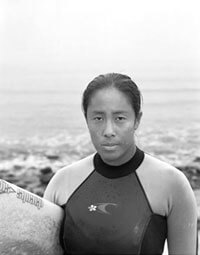A photographer chronicles surfers who tame the Malibu waves
catherine opie/courTesy gorney bravin & lee gallery
“Margaret” and “Ken,” two photographs from 2003 of Californian surfers taken by Catherine Opie, a UCLA professor, whose work is part of the Whitney Biennial.
The community that Catherine Opie chronicles in “Surfers” is one that is configured around surfers who brave the waves off Malibu, California. The exhibition includes twelve portraits of surfers, both men and women of various ages.
Each photograph is titled by the name of the subject. Among them are Margaret, who looks suspiciously at the camera; Adam, who looks about 12 years old; and Erin, who looks like she meticulously applies her makeup. Twenty-somethings Larkie and Rachel seem like they belong on the MTV reality TV show, “Surfer Girls,” while seniors Devi and Ken bring to mind the heyday of “California Dreamin’” and the sage writings of Joan Didion, whose most recent book, “Where I was From,” tries to come to grips with what it really means to be from California.
Opie snapped all her subjects on a murky day just as they emerged from the Pacific Ocean. Droplets of water drip from their faces. Most of them hold their surfboards tucked under their arms, making the boards seem like fertility objects and the surfers like members of some lost tribe. We are reminded of the photographer Robert Mapplethorpe’s 1982 portrait of the artist Louise Bourgeois in which the grinning subject totes a giant penis sculpture under her arm. (Opie, a professor of photography at UCLA, recently curated a retrospective of Mapplethorpe’s work at the Marc Selwyn Fine Art gallery in Los Angeles.)
In addition to the portraits, there are photographs of the wide, grey ocean, with surfers dotting the seascape. Selections of these shots are included in this year’s Whitney Biennial.
In her photography, Opie has long addressed the question, “What makes a community?” She started out exploring the farthest reaches of this question in the mid-1990s with portraits of her friends in the Los Angeles queer leather community. In the process, Opie snapped a few gripping self-portraits, including one in which she is pictured with a stick figure drawing of a house and two women holding hands sliced into her back.
Another series, entitled “Normal,” came about when Opie drove across the country to photograph families of lesbian couples in their normal, domestic settings.
In the well-executed “Surfers,” Opie proves once again that her grasp on community is that it is somewhere between slippery and rough.
We also publish:




































